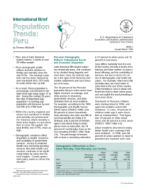Population Trends: Peru
Population Trends: Peru
Introduction
Latin America’s fifth largest nation has historically been, and continues to be, divided along linguistic and class lines. Lima, the national capital, is the apex of the hierarchy and smaller settlements and rural areas are at its base.
The 70 percent of the Peruvian population living in urban areas have higher incomes, on average, and more access to resources, government services, and other amenities than do rural residents. For example, according to the 1996 Demographic and Health Survey (DHS) report (ENDES 1996), over 90 percent of urban households have electricity; less than one-fifth of rural households do (Table 2.9). Similarly, only 6 percent of females ages 6 and above living in urban places have no education, but 24 percent of rural females have no formal schooling (ENDES 1996: Table 2.6). The percentage of females with at least a secondary education is 57 percent in urban areas and 16 percent in rural areas.




